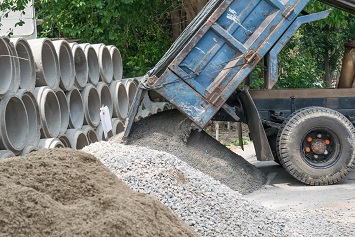Unloading a dump truck can be a hazardous operation, particularly when the ground is uneven or when the load is being delivered into a pit. This is a common scenario at mining sites. Moreover, dump trucks loaded with coal can face even higher risks because the load can be wet, freeze in the bed, and stick in the bed. When the bed is raised, a frozen load can cause the truck to tip and even roll over. These hazards and ways to mitigate them were outlined in a Safety Alert from the Mine Safety and Health Administration (MSHA). Employers at coal mines, construction sites, highway projects, and any other venues where dumping occurs should regularly review their safety procedures; and with winter approaching, now is a good time to provide drivers with instructions and training on avoiding frozen loads and implementing enhanced safety procedures if loads are frozen.
Driver Death
In its alert, MSHA notes a February 2017 incident where a driver of a tractor trailer coal truck died when his truck tipped over as he was attempting to dump a load of coal that was frozen. As the bed was raised, the trailer rocked and eventually tipped over. The driver made the error of jumping from the cab as the truck was moving. He was struck by the truck and was fatally injured.
“A raised truck bed can easily overturn due to its size and weight,” states MSHA. “Uneven ground, unbalanced load, and/or underinflated work tires increase the hazards associated with this task. These hazards can be avoided with proper training and implementation of best practices.”
Best Practices
MSHA recommends that drivers:
- Keep tires properly inflated and ensure they are not worn.
- Use antifreeze in cold weather to prevent material from freezing and sticking in the truck bed. Ensure the load is evenly distributed.
- Never overload the upper portion of the truck bed.
- Keep your truck and trailer in a straight line when backing up, and never move faster than walking speed.
- Stay in the cab with your seat belt on during the entire dumping process. Never attempt to exit or jump from an overturning truck. Remaining in the truck is the single best thing drivers can do to protect themselves at a mine.
- Dump only on level surfaces, and never dump when surfaces are uneven, loose, or not properly compacted.
Operators should:
- Mount a thermometer at the dump site to inform truck drivers of freezing conditions.
- Adhere to MSHA’s requirement at 30 CFR 77.1708 to “establish and maintain a program of instruction with respect to the safety regulations and procedures to be followed at the mine and shall publish and distribute to each employee, and post in conspicuous places throughout the mine, all such safety regulations and procedures established in accordance with the provisions of this section.” This regulation encompasses the operation of dump trucks at mine sites.
Quantify Risks
Employers can find a more detailed discussion of dump truck hazards, incidents, and safety in Haulage Truck Dump Site Safety: An Examination of Reported Injuries, a 2001 National Institute for Occupational Safety and Health (NIOSH) report.
“The amount of risk depends on many factors. These factors include dump site layout, dump site stability, truck performance, amount of light, decision-making abilities of equipment operators, and weather conditions. Important tasks for safety professionals are to quantify work site risks, to provide guidelines for identifying when risks are too great, and to determine what can be done to reduce these risks,” stated NIOSH.
The report goes into detail on the different types of dumping that occur at mines and other sites (e.g., edge dumping and short dumping), the hazards associated with each type, and safety measures that address specific risks.

